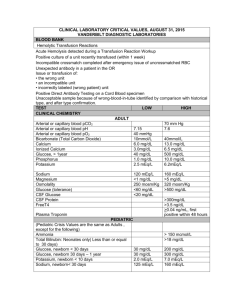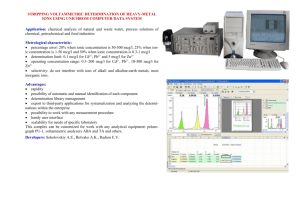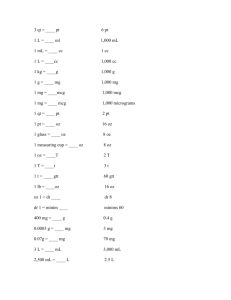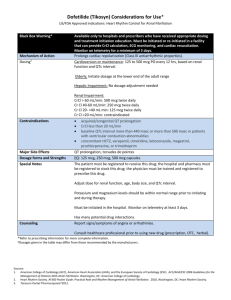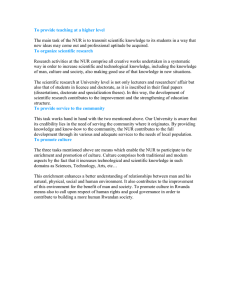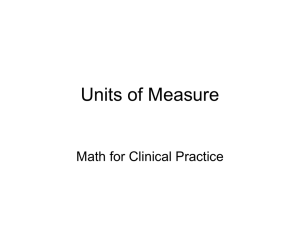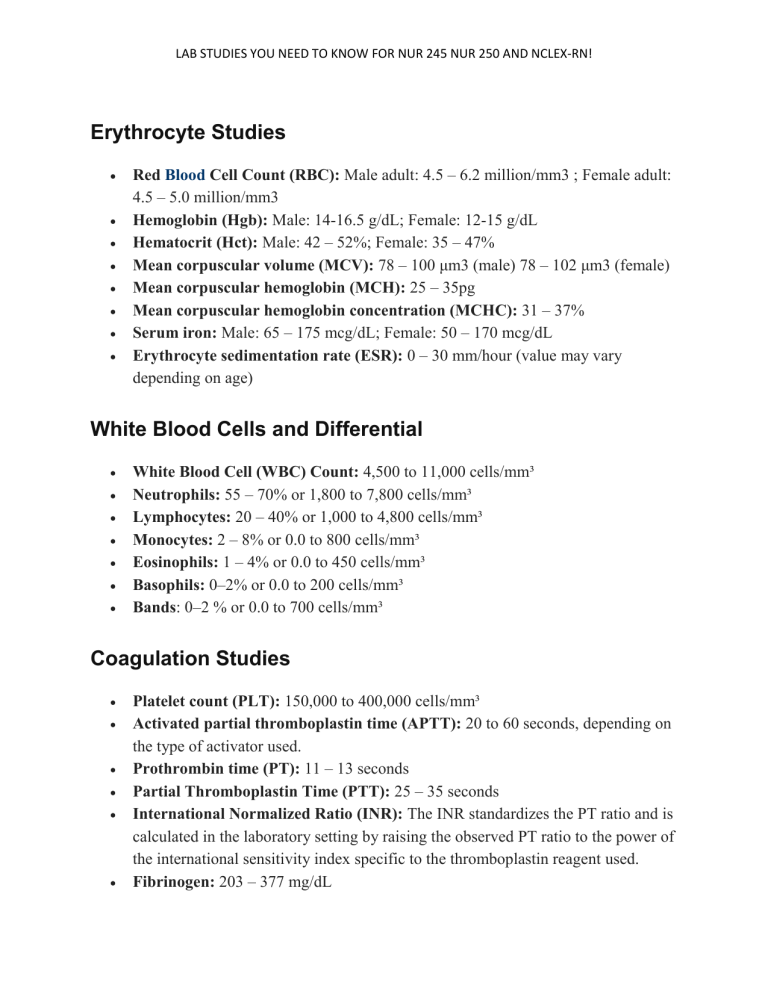
LAB STUDIES YOU NEED TO KNOW FOR NUR 245 NUR 250 AND NCLEX-RN! Erythrocyte Studies Red Blood Cell Count (RBC): Male adult: 4.5 – 6.2 million/mm3 ; Female adult: 4.5 – 5.0 million/mm3 Hemoglobin (Hgb): Male: 14-16.5 g/dL; Female: 12-15 g/dL Hematocrit (Hct): Male: 42 – 52%; Female: 35 – 47% Mean corpuscular volume (MCV): 78 – 100 μm3 (male) 78 – 102 μm3 (female) Mean corpuscular hemoglobin (MCH): 25 – 35pg Mean corpuscular hemoglobin concentration (MCHC): 31 – 37% Serum iron: Male: 65 – 175 mcg/dL; Female: 50 – 170 mcg/dL Erythrocyte sedimentation rate (ESR): 0 – 30 mm/hour (value may vary depending on age) White Blood Cells and Differential White Blood Cell (WBC) Count: 4,500 to 11,000 cells/mm³ Neutrophils: 55 – 70% or 1,800 to 7,800 cells/mm³ Lymphocytes: 20 – 40% or 1,000 to 4,800 cells/mm³ Monocytes: 2 – 8% or 0.0 to 800 cells/mm³ Eosinophils: 1 – 4% or 0.0 to 450 cells/mm³ Basophils: 0–2% or 0.0 to 200 cells/mm³ Bands: 0–2 % or 0.0 to 700 cells/mm³ Coagulation Studies Platelet count (PLT): 150,000 to 400,000 cells/mm³ Activated partial thromboplastin time (APTT): 20 to 60 seconds, depending on the type of activator used. Prothrombin time (PT): 11 – 13 seconds Partial Thromboplastin Time (PTT): 25 – 35 seconds International Normalized Ratio (INR): The INR standardizes the PT ratio and is calculated in the laboratory setting by raising the observed PT ratio to the power of the international sensitivity index specific to the thromboplastin reagent used. Fibrinogen: 203 – 377 mg/dL LAB STUDIES YOU NEED TO KNOW FOR NUR 245 NUR 250 AND NCLEX-RN! Bleeding time: 1 to 3 minutes (Duke method), 3 to 6 minutes (Ivy method) D-Dimer: < 500 ng/mL Serum Electrolytes Potassium (K+): 3.5 – 5.0 mEq/L Sodium (Na+): 135-145 mEq/L Chloride (Cl-): 95 – 105 mEq/L Calcium (Ca+): o Total calcium: 4.5 – 5.5 mEq/L (8.5 to 10.5 mg/dL) o Ionized calcium: 2.5 mEq/L (4.0 – 5.0 mg/dL) 56% of total calcium Phosphorus (P): 1.8 – 2.6 mEq/L (2.7 to 4.5 mg/dL) Magnesium (Mg): 1.6 to 2.6 mg/dL Serum Osmolality: 280 to 300 mOsm/kg Serum bicarbonate: 22 to 29 mEq/L Renal Function Studies Creatinine (Cr): 0.6 to 1.3 mg/dL Blood urea nitrogen (BUN): 8 to 25 mg/dL Glucose Studies Glucose: Glucose, fasting: 70 – 110 mg/dL o Glucose, monitoring: 60 – 110 mg/dL o Glucose, 2-hr postprandial: < 140mg/dL Glucose Tolerance Test (GTT) o 70 – 110 mg/dL (baseline fasting) o 110 – 170 mg/dL (30 minute fasting) o 120 – 170 mg/dL (60 minute fasting) o 100 – 140 mg/dL (90 minute fasting) o 70 – 120 mg/dL (120 minute fasting) Glycosylated hemoglobin (HbA1c) o 7% or lower (good control of diabetes) o LAB STUDIES YOU NEED TO KNOW FOR NUR 245 NUR 250 AND NCLEX-RN! 7% to 8% (fair control of diabetes) o Higher than 8 % (poor control of diabetes) Diabetes Mellitus autoantibody panel: Less than 1:4 titer with no antibody detected o Arterial Blood Gases (ABGs) Arterial blood pH: 7.35 – 7.45 Oxygen saturation (SaO2): >95% Partial pressure of carbon dioxide (PCO2): 35 – 45 mmHg Partial pressure of oxygen (PaO2): 80 – 100 mmHg Bicarbonate (HCO3): 22 – 26 mEq/L Liver Function Tests Alanine Aminotransferase (ALT): o Male: 10 to 55 units/L o Female: 7 to 30 units/L Aspartate Aminotransferase (AST): o Male: 10 – 40 units/L o Female: 9 – 25 units/L Total bilirubin: 0.3 – 1.0 mg/dL Direct bilirubin (conjugated): 0.0 to 0.2 mg/dL Indirect bilirubin (unconjugated): 0.1 to 1 mg/dL; Critical level: > 12 mg/dL Albumin: 3.4 to 5 g/dL Ammonia: 35 – 65 mcg/dL (adult) Amylase: 25 to 151 units/L Lipase: 10 to 140 units/L Protein: 6 to 8 g/dL Lipoprotein Profile Cholesterol: Less than 200 mg/dL High-density lipoprotein (HDL): 30 to 70 mg/dL Low density lipoprotein (LDL): Less than 130 mg/dL LAB STUDIES YOU NEED TO KNOW FOR NUR 245 NUR 250 AND NCLEX-RN! Triglycerides: Less than 150 mg/dL Cardiac Markers and Serum Enzymes Creatine kinase (CK) o Male: 38 – 174 U/L o Female: 26 – 140 U/L Creatinine kinase isoenzymes o CK-MM: 95% – 100% of total o CK-MB: 0% – 5% of total o CK-BB: 0% Myoglobin: 5–70 ng/mL Troponin: o Troponin: Less than 0.04 ng/mL; above 0.40 ng/mL may indicate MI o Troponin T: Greater than 0.1 to 0.2 ng/mL may indicate MI o Troponin I: Less than 0.6 ng/mL; >1.5 ng/mL indicates myocardial infarction Atrial natriuretic peptide (ANP): 22 to 27 pg/mL Brain natriuretic peptide (BNP): less than 100 pg/mL C-type natriuretic peptide (CNP): reference range provided with results should be reviewed HIV and AIDS Testing CD4+ T-cell count: o Normal: 500 to 1600 cells/L. o Severe: Less than 200 cells/L o CD4-to-CD8 ratio: 2:1 Thyroid function test Triiodothyronine (T₃): 80 to 230 ng/dL Thyroxine (T₄): 5 to 12 mcg/dL Thyroxine, free (FT₄): 0.8 to 2.4 ng/dL Thyroid-stimulating hormone (thyrotropin): 0.2 to 5.4 microunits/mL LAB STUDIES YOU NEED TO KNOW FOR NUR 245 NUR 250 AND NCLEX-RN! Urinalysis Color: Pale yellow Odor: Aromatic odor Turbidity: Clear Specific gravity: 1.016 to 1.022 pH: 4.5 to 7.8 Protein: Negative Ketones: Negative Bilirubin: Negative Glucose: >0.5 g/day Red blood cells: < 3 cells/HPF White blood cells: < or = 4 cells/HPF Bacteria: None or >1000/ml Casts: None to few Crystals: None Uric acid: 250 to 750 mg/24 hours Sodium: 40 to 220 mEq/24 hours Potassium: 25 to 125 mEq/24 hours Magnesium: 7.3 – 12.2 mg/dL Hepatitis Testing Hepatitis A: Presence of immunoglobulin M (IgM) antibody to Hepatitis A and presence of total antibody (IgG and IgM) may suggest recent or current Hep A infection. Hepatitis B: Detection of Hep B core Antigen (HBcAg), envelope antigen (HBeAg), and surface antigen (HBsAg), or their corresponding antibodies. Hepatitis C: Confirmed by the presence of antibodies to Hep C virus. Hepatitis D: Detection of Hep D antigen (HDAg) early in the course of infection and detection of Hep D virus antibody in later stages of the disease. Hepatitis E: Specific serological tests for hepatitis E virus include detection of IgM and IgG antibodies to hepatitis E. LAB STUDIES YOU NEED TO KNOW FOR NUR 245 NUR 250 AND NCLEX-RN! Therapeutic Drug Levels Acetaminophen (Tylenol): 10 to 20 mcg/mL Carbamazepine (Tegretol): 5 to 12 mcg/mL Digoxin (Lanoxin): 0.5 to 2 ng/mL Gentamicin (Garamycin): 5 – 10 mcg/mL (peak); <2.0 mcg/mL (trough) Lithium (Lithobid): 0.5 to 1.2 mEq/L Magnesium sulfate: 4 to 7 mg/dL Phenobarbital (Luminal): 10 to 30 mcg/mL Phenytoin (Dilantin): 10 to 20 mcg/mL Salicylate: 100 to 250 mcg/mL Theophylline: 10 to 20 mcg/dL Tobramycin (Tobrex): 5 – 10 mcg/mL (peak); 0.5 – 2.0 mcg/mL (trough) Valproic acid (Depakene): 50 – 100 mcg/mL Vancomycin (Vancocin): 20 – 40 mcg/mL (peak); 5 – 15 mcg/mL (trough)
